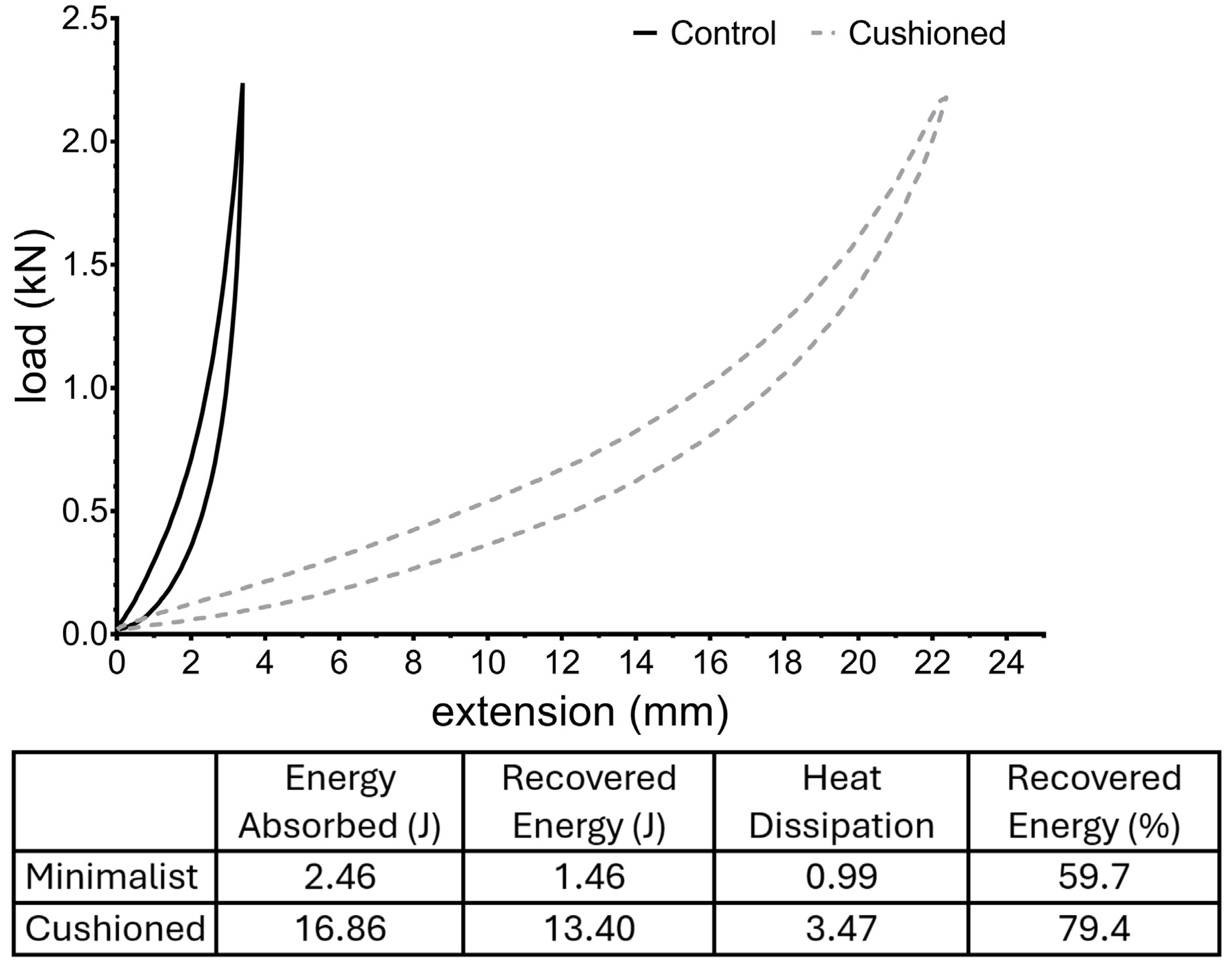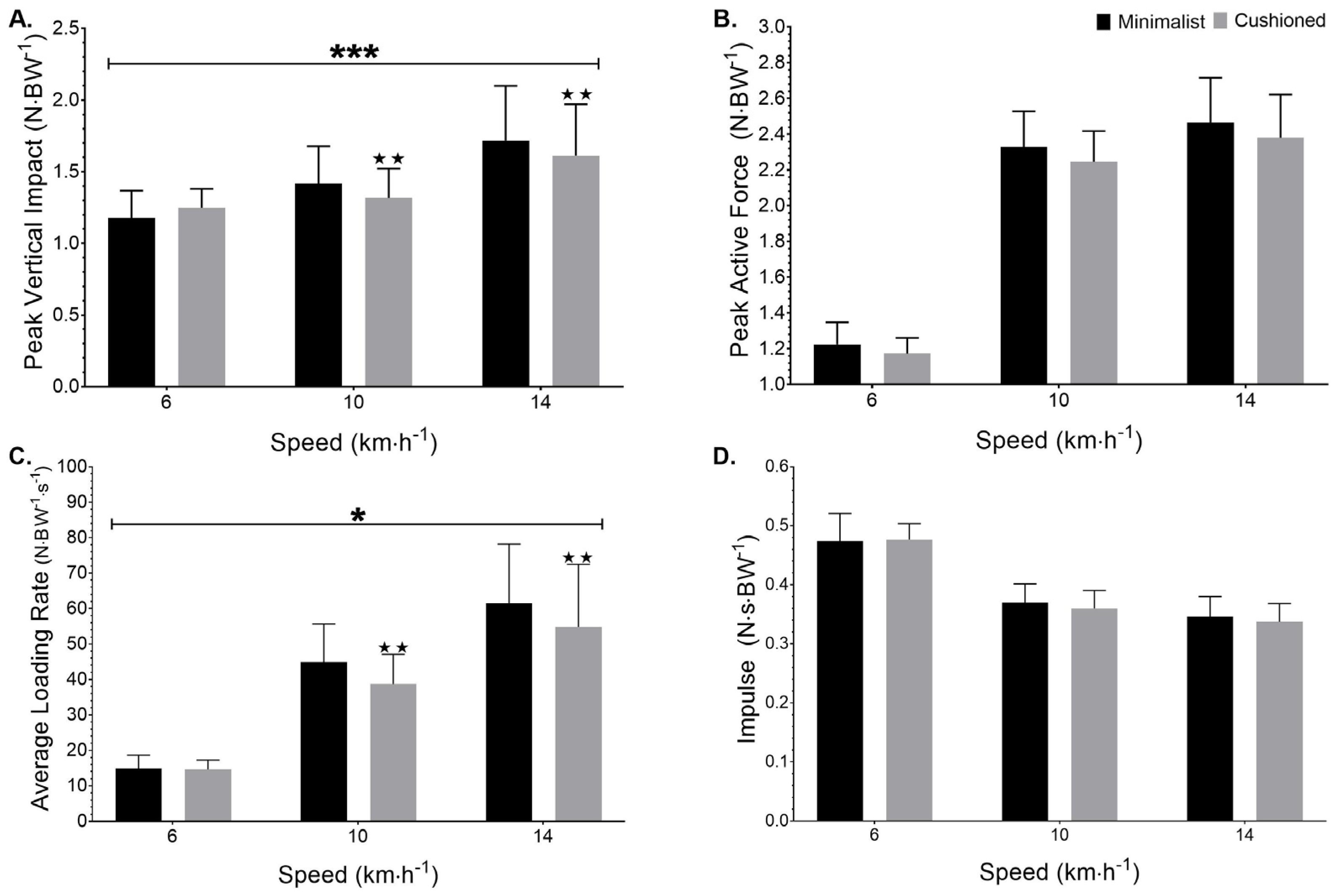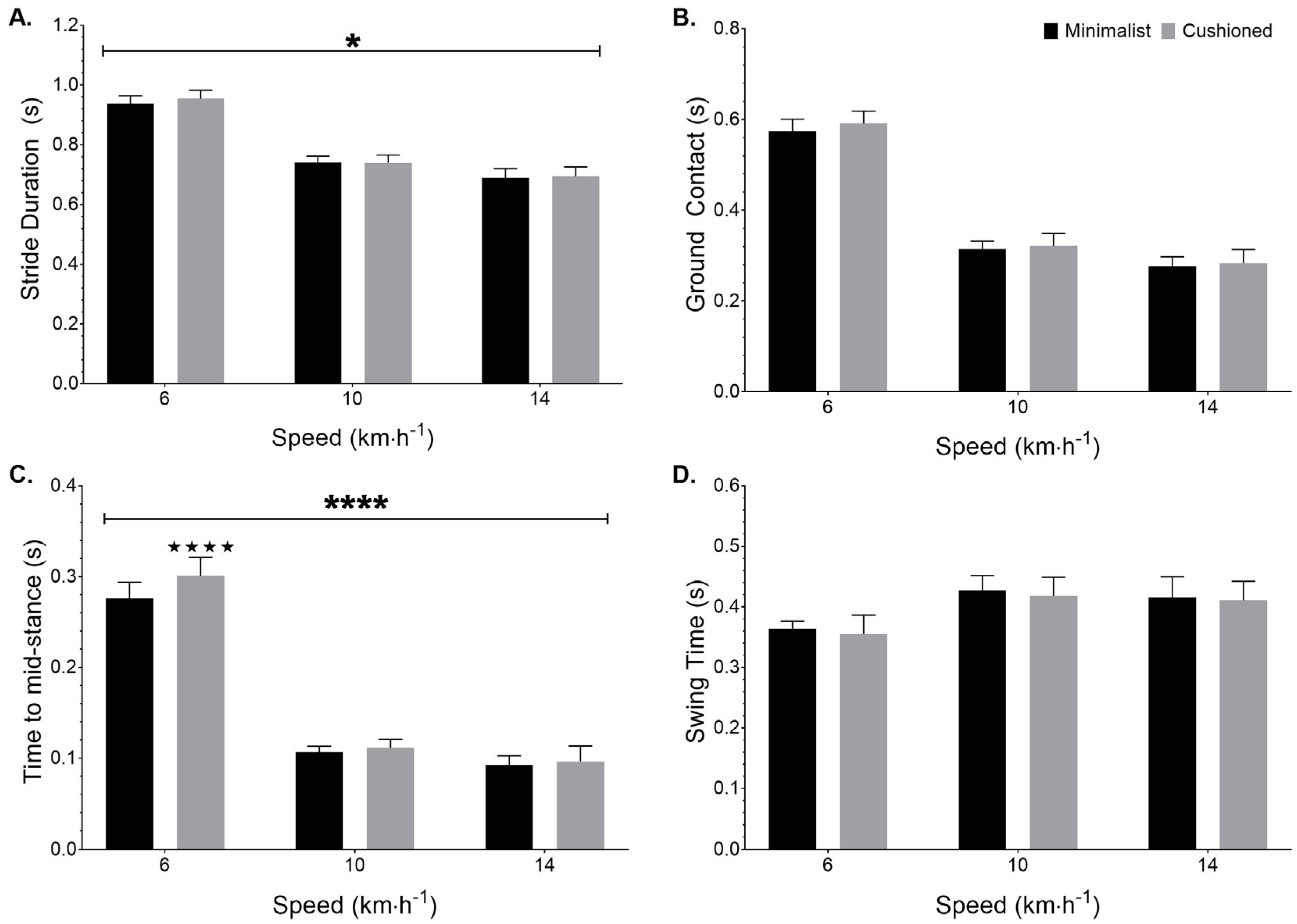The Effects of Cushioning Properties on Parameters of Gait in Habituated Females While Walking and Running
Abstract
Featured Application
Abstract
1. Introduction
2. Materials and Methods
2.1. Participants
2.2. Procedures and Measurements
Mechanical Testing
3. Results
3.1. Mechanical Properties
3.2. Kinetic Data Analysis
3.3. Kinematic Data Analysis
4. Discussion
5. Conclusions
Author Contributions
Funding
Institutional Review Board Statement
Informed Consent Statement
Data Availability Statement
Acknowledgments
Conflicts of Interest
References
- Bullo, V.; Gobbo, S.; Vendramin, B.; Duregon, F.; Cugusi, L.; Di Blasio, A.; Bocalini, D.S.; Zaccaria, M.; Bergamin, M.; Ermolao, A. Nordic Walking Can Be Incorporated in the Exercise Prescription to Increase Aerobic Capacity, Strength, and Quality of Life for Elderly: A Systematic Review and Meta-Analysis. Rejuvenation Res. 2018, 21, 141–161. [Google Scholar] [CrossRef]
- Scheerder, J.; Breedveld, K.; Borgers, J. Running Across Europe: The Rise and Size of One of the Largest Sport Markets; Springer: London, UK, 2015. [Google Scholar]
- Lafortune, M.A.; Lake, M.J.; Hennig, E.M. Differential shock transmission response of the human body to impact severity and lower limb posture. J. Biomech. 1996, 29, 1531–1537. [Google Scholar] [CrossRef] [PubMed]
- Voloshin, A.S.; Mizrahi, J.; Verbitsky, O.; Isakov, E. Dynamic loading on the human musculoskeletal system—Effect of fatigue. Clin. Biomech. 1998, 13, 515–520. [Google Scholar] [CrossRef]
- Winter, S.L.; Challis, J.H. Classifying the variability in impact and active peak vertical ground reaction forces during running using DFA and ARFIMA models. Hum. Mov. Sci. 2017, 51, 153–160. [Google Scholar] [CrossRef]
- Hamill, J.; Derrick, T.; Holt, K. Shock attenuation and stride frequency during running. Hum. Mov. Sci. 1995, 14, 45–60. [Google Scholar] [CrossRef]
- Davis, S.I.; Bradley, J.B.; David, R.M. Greater vertical impact loading in female runners with medically diagnosed injuries: A prospective investigation. Br. J. Sports Med. 2016, 50, 887. [Google Scholar] [CrossRef]
- Milner, C.E.; Ferber, R.; Pollard, C.D.; Hamill, J.; Davis, I.S. Biomechanical factors associated with tibial stress fracture in female runners. Med. Sci. Sports Exerc. 2006, 38, 323–328. [Google Scholar] [CrossRef] [PubMed]
- Hamill, J.; Bates, B.T.; Knutzen, K.M.; Sawhill, J.A. Variations in ground reaction force parameters at different running speeds. Hum. Mov. Sci. 1983, 2, 47–56. [Google Scholar] [CrossRef]
- Dorn, T.W.; Schache, A.G.; Pandy, M.G. Muscular strategy shift in human running: Dependence of running speed on hip and ankle muscle performance. J. Exp. Biol. 2012, 215, 1944–1956. [Google Scholar] [CrossRef] [PubMed]
- Nigg, B.M.; Bahlsen, H.A.; Luethi, S.M.; Stokes, S. The influence of running velocity and midsole hardness on external impact forces in heel-toe running. J. Biomech. 1987, 20, 951–959. [Google Scholar] [CrossRef]
- Arampatzis, A.; Brüggemann, G.-P.; Metzler, V. The effect of speed on leg stiffness and joint kinetics in human running. J. Biomech. 1999, 32, 1349–1353. [Google Scholar] [CrossRef] [PubMed]
- Nilsson, J.; Thorstensson, A. Ground reaction forces at different speeds of human walking and running. Acta Physiol. Scand. 1989, 136, 217–227. [Google Scholar] [CrossRef]
- Mercer, J.A.; Bezodis, N.E.; Russell, M.; Purdy, A.; Delion, D. Kinetic consequences of constraining running behavior. J. Sports Sci. Med. 2005, 4, 144–152. [Google Scholar]
- Nigg, B.M.; Cole, G.K.; Brüggemann, G.-P. Impact forces during heel-toe running. J. Appl. Biomech. 1995, 11, 407–432. [Google Scholar] [CrossRef]
- Aerts, P.; Clercq, D.D. Deformation characteristics of the heel region of the shod foot during a simulated heel strike: The effect of varying midsole hardness. J. Sports Sci. 1993, 11, 449–461. [Google Scholar] [CrossRef] [PubMed]
- Aimar, C.; Orgéas, L.; Rolland du Roscoat, S.; Bailly, L.; Ferré Sentis, D. Compression fatigue of elastomeric foams used in midsoles of running shoes. Footwear Sci. 2024, 16, 93–103. [Google Scholar] [CrossRef]
- Shorten, M.; Mientjes, M.I.V. The ‘heel impact’ force peak during running is neither ‘heel’ nor ‘impact’ and does not quantify shoe cushioning effects. Footwear Sci. 2011, 3, 41–58. [Google Scholar] [CrossRef]
- Bergstra, S.A.; Kluitenberg, B.; Dekker, R.; Bredeweg, S.W.; Postema, K.; Van den Heuvel, E.R.; Hijmans, J.M.; Sobhani, S. Running with a minimalist shoe increases plantar pressure in the forefoot region of healthy female runners. J. Sci. Med. Sport 2015, 18, 463–468. [Google Scholar] [CrossRef] [PubMed]
- Kulmala, J.-P.; Kosonen, J.; Nurminen, J.; Avela, J. Running in highly cushioned shoes increases leg stiffness and amplifies impact loading. Sci. Rep. 2018, 8, 17496. [Google Scholar] [CrossRef]
- Hannigan, J.J.; Pollard, C.D. Differences in running biomechanics between a maximal, traditional, and minimal running shoe. J. Sci. Med. Sport 2020, 23, 15–19. [Google Scholar] [CrossRef]
- Stoneham, R.; Barry, G.; Saxby, L.; Waters, L.; Wilkinson, M. Differences in stride length and lower limb moments of recreational runners during over-ground running while barefoot, in minimalist and in maximalist running shoes. Footwear Sci. 2021, 13, 133–141. [Google Scholar] [CrossRef]
- Hoogkamer, W.; Kipp, S.; Frank, J.H.; Farina, E.M.; Luo, G.; Kram, R. A Comparison of the Energetic Cost of Running in Marathon Racing Shoes. Sports Med. 2018, 48, 1009–1019. [Google Scholar] [CrossRef] [PubMed]
- Worobets, J.; Wannop, J.W.; Tomaras, E.; Stefanyshyn, D. Softer and more resilient running shoe cushioning properties enhance running economy. Footwear Sci. 2014, 6, 147–153. [Google Scholar] [CrossRef]
- Huang, J. Effects of the material of running shoes on biomechanical characteristics during running. Mech. Adv. Mater. Struct. 2019, 26, 2017–2022. [Google Scholar] [CrossRef]
- Baltich, J.; Maurer, C.; Nigg, B.M. Increased Vertical Impact Forces and Altered Running Mechanics with Softer Midsole Shoes. PLoS ONE 2015, 10, e0125196. [Google Scholar] [CrossRef] [PubMed]
- Clarke, T.E.; Frederick, E.C.; Cooper, L.B. Effects of Shoe Cushioning Upon Ground Reaction Forces in Running. Int. J. Sports Med. 1983, 04, 247–251. [Google Scholar] [CrossRef] [PubMed]
- Dixon, S.J.; Collop, A.C.; Batt, M.E. Surface effects on ground reaction forces and lower extremity kinematics in running. Med. Sci. Sports Exerc. 2000, 32, 1919–1926. [Google Scholar] [CrossRef] [PubMed]
- Fu, L.; Gu, Y.; Mei, Q.; Baker, J.S.; Fernandez, J. A kinematics analysis of the lower limb during running with different sports shoes. Proc. Inst. Mech. Eng. Part P J. Sports Eng. Technol. 2019, 233, 46–52. [Google Scholar] [CrossRef]
- McNair, P.J.; Marshall, R.N. Kinematic and kinetic parameters associated with running in different shoes. Br. J. Sports Med. 1994, 28, 256–260. [Google Scholar] [CrossRef]
- De Wit, B.; De Clercq, D.; Aerts, P. Biomechanical analysis of the stance phase during barefoot and shod running. J. Biomech. 2000, 33, 269–278. [Google Scholar] [CrossRef] [PubMed]
- Lieberman, D.E.; Venkadesan, M.; Werbel, W.A.; Daoud, A.I.; D’Andrea, S.; Davis, I.S.; Mang’Eni, R.O.; Pitsiladis, Y. Foot strike patterns and collision forces in habitually barefoot versus shod runners. Nature 2010, 463, 531–535. [Google Scholar] [CrossRef] [PubMed]
- Thompson, M.A.; Gutmann, A.; Seegmiller, J.; McGowan, C.P. The effect of stride length on the dynamics of barefoot and shod running. J. Biomech. 2014, 47, 2745–2750. [Google Scholar] [CrossRef] [PubMed]
- Pollard, C.D.; Ter Har, J.A.; Hannigan, J.J.; Norcross, M.F. Influence of Maximal Running Shoes on Biomechanics Before and After a 5K Run. Orthop. J. Sports Med. 2018, 6, 2325967118775720. [Google Scholar] [CrossRef] [PubMed]
- Aminaka, N.; Arthur, K.; Porcari, J.P.; Foster, C.; Cress, M.; Hahn, C. No immediate effects of highly cushioned shoes on basic running biomechanics. Kinesiology 2018, 50, 124–130. [Google Scholar] [CrossRef]
- Agresta, C.; Kessler, S.; Southern, E.; Goulet, G.C.; Zernicke, R.; Zendler, J.D. Immediate and short-term adaptations to maximalist and minimalist running shoes. Footwear Sci. 2018, 10, 95–107. [Google Scholar] [CrossRef]
- Sinclair, J.; Fau-Goodwin, J.; Richards, J.; Shore, H. The influence of minimalist and maximalist footwear on the kinetics and kinematics of running. Footwear Sci. 2016, 8, 33–39. [Google Scholar] [CrossRef]
- Huber, G.; Jaitner, T.; Schmidt, M. Acute effects of minimalist shoes on biomechanical gait parameters in comparison to walking barefoot and in cushioned shoes: A randomised crossover study. Footwear Sci. 2022, 14, 123–130. [Google Scholar] [CrossRef]
- Ogston, J.K. Comparison of in-shoe plantar loading forces between minimalist and maximalist cushion running shoes. Footwear Sci. 2019, 11, 55–61. [Google Scholar] [CrossRef]
- Clermont, C.A.; Benson, L.C.; Osis, S.T.; Kobsar, D.; Ferber, R. Running patterns for male and female competitive and recreational runners based on accelerometer data. J. Sports Sci. 2019, 37, 204–211. [Google Scholar] [CrossRef] [PubMed]
- Arendt, E.; Agel, J.; Heikes, C.; Griffiths, H. Stress Injuries to Bone in College Athletes:A Retrospective Review of Experience at a Single Institution*. Am. J. Sports Med. 2003, 31, 959–968. [Google Scholar] [CrossRef]
- Dempster, J.; Dutheil, F.; Ugbolue, U.C. The Prevalence of Lower Extremity Injuries in Running and Associated Risk Factors: A Systematic Review. Phys. Act. Health 2021, 5, 133. [Google Scholar] [CrossRef]
- Dufek, J.S.; Mercer, J.A.; Griffin, J.R. The Effects of Speed and Surface Compliance on Shock Attenuation Characteristics for Male and Female Runners. J. Appl. Biomech. 2009, 25, 219–228. [Google Scholar] [CrossRef] [PubMed][Green Version]
- Malisoux, L.; Delattre, N.; Urhausen, A.; Theisen, D. Shoe Cushioning Influences the Running Injury Risk According to Body Mass: A Randomized Controlled Trial Involving 848 Recreational Runners. Am. J. Sports Med. 2020, 48, 473–480. [Google Scholar] [CrossRef] [PubMed]
- Hoffman, M.D. Anthropometric Characteristics of Ultramarathoners. Int. J. Sports Med. 2008, 29, 808–811. [Google Scholar] [CrossRef] [PubMed]
- Francis, P.; Schofield, G.; Mackay, L. Being barefoot. Prevalence at home, in school and during sport: A cross-sectional survey of 714 New Zealand secondary school boys. J. Foot Ankle Res. 2018, 11, 42. [Google Scholar] [CrossRef] [PubMed]
- Charmant, J. Kinovea, version 0.9.5. 2021. Available online: https://www.kinovea.org/ (accessed on 17 December 2024).
- Coetzee, D.R.; Albertus, Y.; Tam, N.; Tucker, R. Conceptualizing minimalist footwear: An objective definition. J. Sports Sci. 2018, 36, 949–954. [Google Scholar] [CrossRef]
- Renner, K.E.; Peebles, A.T.; Socha, J.J.; Queen, R.M. The impact of sampling frequency on ground reaction force variables. J. Biomech. 2022, 135, 111034. [Google Scholar] [CrossRef]
- Wright, I.C.; Neptune, R.R.; van den Bogert, A.J.; Nigg, B.M. Passive regulation of impact forces in heel-toe running. Clin. Biomech. 1998, 13, 521–531. [Google Scholar] [CrossRef] [PubMed]
- Su, B.L.; Song, R.; Guo, L.Y.; Yen, C.W. Characterizing gait asymmetry via frequency sub-band components of the ground reaction force. Biomed. Signal Process. Control 2015, 18, 56–60. [Google Scholar] [CrossRef]
- Chan, Z.Y.S.; Au, I.P.H.; Lau, F.O.Y.; Ching, E.C.K.; Zhang, J.H.; Cheung, R.T.H. Does maximalist footwear lower impact loading during level ground and downhill running? Eur. J. Sport. Sci. 2018, 18, 1083–1089. [Google Scholar] [CrossRef]
- ISO 20344:2021; Personal Protective Equipment—Test Methods for Footwear. ISO: Geneva, Switzerland, 2021.
- Mero, A.; Komi, P.V. Force-, EMG-, and elasticity-velocity relationships at submaximal, maximal and supramaximal running speeds in sprinters. Eur. J. Appl. Physiol. Occup. Physiol. 1986, 55, 553–561. [Google Scholar] [CrossRef] [PubMed]
- Cavanagh, P.R. The Biomechanics of Lower Extremity Action in Distance Running. Foot Ankle 1987, 7, 197–217. [Google Scholar] [CrossRef]
- Ricard, M.D.; Veatch, S. Effect of Running Speed and Aerobic Dance Jump Height on Vertical Ground Reaction Forces. J. Appl. Biomech. 1994, 10, 14–27. [Google Scholar] [CrossRef]
- Bertelsen, M.L.; Hulme, A.; Petersen, J.; Brund, R.K.; Sørensen, H.; Finch, C.F.; Parner, E.T.; Nielsen, R.O. A framework for the etiology of running-related injuries. Scand. J. Med. Sci. Sports 2017, 27, 1170–1180. [Google Scholar] [CrossRef] [PubMed]
- Shorten, M.R. The energetics of running and running shoes. J. Biomech. 1993, 26 (Suppl. S1), 41–51. [Google Scholar] [CrossRef]
- Shorten, M.R. Energy return in footwear–revisited. Footwear Sci. 2024, 16, 149–162. [Google Scholar] [CrossRef]
- Möhler, F.; Fadillioglu, C.; Stein, T. Fatigue-Related Changes in Spatiotemporal Parameters, Joint Kinematics and Leg Stiffness in Expert Runners During a Middle-Distance Run. Front. Sports Act. Living 2021, 3, 634258. [Google Scholar] [CrossRef]
- Nigg, B.M.; Vienneau, J.; Smith, A.C.; Trudeau, M.B.; Mohr, M.; Nigg, S.R. The Preferred Movement Path Paradigm: Influence of Running Shoes on Joint Movement. Med. Sci. Sports Exerc. 2017, 49, 1641–1648. [Google Scholar] [CrossRef]
- Kyröläinen, H.; Belli, A.; Komi, P.V. Biomechanical factors affecting running economy. Med. Sci. Sports Exerc. 2001, 33, 1330–1337. [Google Scholar] [CrossRef]




| Shoe | Minimalist | Cushion | Minimalist | Cushion | Minimalist | Cushion |
|---|---|---|---|---|---|---|
| Speed (km∙h−1) | 6 | 6 | 10 | 10 | 14 | 14 |
| Stride Duration | 1.2 ± 0.3 | 1.1 ± 0.3 | 1.0 ± 0.2 | 1.2 ± 0.4 | 1.1 ± 0.3 | 1.1 ± 0.3 |
| Stride Frequency | 1.3 ± 0.3 | 1.3 ± 0.4 | 1.0 ± 0.2 | 1.2 ± 0.4 | 1.1 ± 0.3 | 1.1 ± 0.3 |
| Ground Contact Time | 1.7 ± 0.5 | 2.4 ± 1.3 | 4.6 ± 0.7 | 4.6 ± 0.8 | 4.6 ± 1.7 | 5.0 ± 1.2 |
| Swing Time | 3.8 ± 0.7 | 4.3 ± 1.4 | 3.5 ± 0.6 | 3.2 ± 0.8 | 3.8 ± 2.0 | 3.7 ± 1.4 |
| Peak Impact Force | 3.5 ± 1.4 | 3.2 ± 0.8 | 7.1 ± 1.0 | 7.0 ± 2.1 | 6.8 ± 1.8 | 6.5 ± 1.1 |
| Loading Rate | 13.6 ± 4.8 | 11.2 ± 2.3 | 10.1 ± 2.4 | 11.4 ± 3.0 | 8.4 ± 1.9 | 7.4 ± 0.9 |
| Active Peak Force | 2.9 ± 1.7 | 2.8 ± 0.8 | 1.6 ± 0.4 | 2.2 ± 0.5 | 1.9 ± 0.4 | 2.6 ± 0.7 |
| Time to Active Peak Force | 2.3 ± 0.6 | 5.7 ± 0.5 | 6.1 ± 1.8 | 7.3 ± 2.4 | 5.7 ± 1.5 | 6.3 ± 2.4 |
| Impulse | 2.4 ± 0.6 | 2.7 ± 1.0 | 3.1 ± 0.4 | 2.8 ± 0.4 | 2.7 ± 1.0 | 2.8 ± 0.9 |
Disclaimer/Publisher’s Note: The statements, opinions and data contained in all publications are solely those of the individual author(s) and contributor(s) and not of MDPI and/or the editor(s). MDPI and/or the editor(s) disclaim responsibility for any injury to people or property resulting from any ideas, methods, instructions or products referred to in the content. |
© 2025 by the authors. Licensee MDPI, Basel, Switzerland. This article is an open access article distributed under the terms and conditions of the Creative Commons Attribution (CC BY) license (https://creativecommons.org/licenses/by/4.0/).
Share and Cite
Macdermid, P.W.; Walker, S.J.; Cochrane, D. The Effects of Cushioning Properties on Parameters of Gait in Habituated Females While Walking and Running. Appl. Sci. 2025, 15, 1120. https://doi.org/10.3390/app15031120
Macdermid PW, Walker SJ, Cochrane D. The Effects of Cushioning Properties on Parameters of Gait in Habituated Females While Walking and Running. Applied Sciences. 2025; 15(3):1120. https://doi.org/10.3390/app15031120
Chicago/Turabian StyleMacdermid, Paul William, Stephanie Julie Walker, and Darryl Cochrane. 2025. "The Effects of Cushioning Properties on Parameters of Gait in Habituated Females While Walking and Running" Applied Sciences 15, no. 3: 1120. https://doi.org/10.3390/app15031120
APA StyleMacdermid, P. W., Walker, S. J., & Cochrane, D. (2025). The Effects of Cushioning Properties on Parameters of Gait in Habituated Females While Walking and Running. Applied Sciences, 15(3), 1120. https://doi.org/10.3390/app15031120







